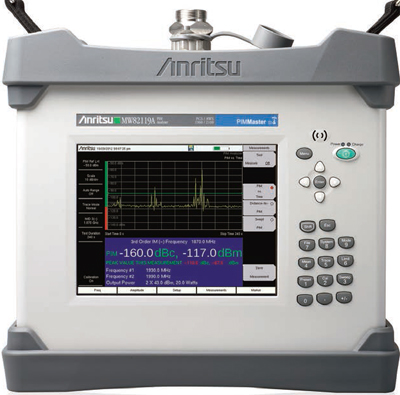
|
|
The Anritsu MW82119A is a battery-operated high power Passive Intermodulation (PIM) testing solution for the major wireless standards in use. PIM is a form of interference generated by passive components that are normally thought of as linear such as connectors, cable assemblies, filters and antennas. However, when subject to high RF power levels found in cellular systems, these devices can generate spurious signals that increase the receiver noise floor and reduce site performance. The PIM Master accurately measures PIM performance by injecting two CW test tones into the antenna feed network and recording the magnitude of the 3rd, 5th, or 7th order intermodulation products falling in the receive band of the system. Even though the package is small and it is battery operated, the MW82119A is a high performance PIM test solution allowing operators to adjust output power from 25 dBm (0.3 Watts) for indoor DAS testing to 46 dBm (40 Watts) for macro site testing.
Specifications.
Measurements
PIM vs. Time 3rd, 5th, and 7th order intermodulation product when in receive band (user selectable).
Noise Floor, Noise Floor vs. Time at selected IM product frequency.
Distance-to-PIM, Distance and relative magnitude of mutiple PIM sources.
Swept PIM, 3rd, 5th, and 7th order intermodulation product when in receive band (user selectable).
RF Test Power
Two CW tones 25 dBm to 46 dBm, 0.1 dBm steps.
Residual PIM Performance: <-117 dBm, <-125 dBm typical ( 2x 43 dBm test tones).
PIM Measurement Range: -70 dBm to -130 dBm.
Test Port: 7/16 DIN, female, 50 ohm.
Options.
0700, LTE 700, Tx1: 734 MHz to 734.5 MHz, Tx2: 746 MHz to 768 MHz RxLower: 698 MHz to 717 MHz, RxUpper: 777 MHz to 806 MHz.
0800, LTE 800, Tx1: 791 MHz to 795 MHz, Tx2: 811.5 MHz to 821 MHz Rx: 832 MHz to 862 MHz.
0850, Cellular 850, Tx1: 869 MHz to 871 MHz, Tx2: 881.5 MHz to 894 MHz Rx: 824 MHz to 849 MHz.
0900, E-GSM 900, Tx1: 925 MHz to 937.5 MHz, Tx2: 951.5 MHz to 960 MHz Rx: 880 MHz to 915 MHz.
0180, DCS 1800, Tx1: 1805 MHz to 1837 MHz, Tx2: 1857.5 MHz to 1880 MHz Rx: 1710 MHz to 1785 MHz.
0193, PCS/AWS, Tx1: 1930 MHz to 1940 MHz, Tx2: 1955 MHz to 1995 MHz, Tx3: 2110 MHz to 2155 MHz, Rx1: 1850 MHz to 1910 MHz (using Tx1 and Tx2), Rx2: 1710 MHz to 1755 MHz (using Tx1 and Tx3).
0210, UMTS 2100, Tx1: 2110 MHz to 2112.5 MHz, Tx2: 2130 MHz to 2170 MHz RxLower: 1920 MHz to 1980 MHz, RxUpper: 2050 MHz to 2090 MHz.
0260, LTE 2600, Tx1: 2620 MHz to 2630 MHz, Tx2: 2650 MHz to 2690 MHz Rx: 2500 MHz to 2570 MHz.
|